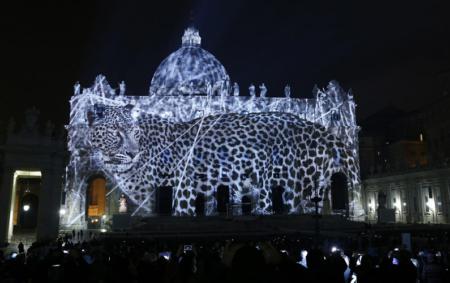Animals at the Vatican
To follow someone's lead, you must see things with the leader's inspiration, and not simply acquiesce in what he says. You might not agree with his inspiration: if you were leader, you might have been inspired in a different and better way. Still, you must be willing, with a generous heart, to discount any negatives of the chosen course of action as well worth it to realize the inspired ideal.
This is all rather abstract, so here are mundane examples. A mother declares one Saturday morning that the family will undertake a complete cleaning of all the bathrooms in the house: she divides the family into "teams," and announces "prizes for first and second place!" Or a father is keen that this year the family will go on a cross-country trip to the Grand Canyon. It's possible for cleaning to be fun, if everyone goes along with the mom's inspiration to make it a game. And long hours in the car can be a unifying challenge, not a burden, if everyone shares in the father's idea that "it's worth it, if we can see the Grand Canyon!" Everything depends on the followers' following the lead with generosity.
The pope's decision to celebrate the beginning of the Year of Mercy with a light show about "our common home" projected onto the façade of St. Peter's seems a similar thing. Critics said it seemed to instrumentalize the church, turning it into a big movie screen. The event seemed manipulative, too, as if trying to funnel off religious piety and redirect it in support of a dubious political cause. The Blessed Mother, by her absence, in contrast seemed diminished on the Feast of the Immaculate Conception. Also, the priorities broadcast by the event seemed twisted: when's the last time a pro-life movie was shown in St. Peter's Square?
While I was watching the entire one hour show, rebroadcast on Vatican TV, my discomfort only grew. First, it was boring. I felt like a captive of someone else's family slide show. One can't look at static pictures of lions, baboons, and lizards, etc., for long, without finding the thing tedious. Actually, whenever the camera panned across the crowd, you could see that the people were looking at their smart phones, not the show. Second, there was no story line and not even any discernible development. The static pictures were far inferior to any episode of Planet Earth. Third, it was tacky. Loud grunting sounds of the pictured animal echoing through St. Peter's Square? Really? Fourth, it seemed a huge waste of money. I'll bet anything that the naturalists at the run-down zoo in Rome had a better use for that money, to teach the love of animals in a more effective and more enduring way. Fifth, the whole extravaganza of light and sound seemed to play up to our culture of distraction, which alienates people from nature and contributes to the very problems which the pope decries. A glitzy hour-long light show indulges us and is easy; a six-hour hike in a nature preserve, say, is difficult but might truly bring someone closer to nature.
Yet shouldn't a Catholic generously put aside all these legitimate "negatives" and see the thing through (what one can guess is) the Holy Father's inspiration?
The intention of the event was the gracious receipt, by the Holy Father, of a gift of "public art," offered in genuine goodwill by admirers of his papacy. As the website of Vulcan, Inc., explains, the Seattle-based company which produced it: "At this unprecedented and historic event, beautiful images of our shared natural world will be projected onto the façade of St. Peter's Basilica in a contemporary work of public art that tells the visual story of the interdependency of humans and life on earth with the planet."
Now I personally don't accept this category of "public art," but many people do, and clearly the Holy Father does, or at least he's open to it. Putting that issue aside, the intention is obviously good. Then to make this gift available to a large audience -- that's a good intention too. To have a big display which people can enjoy after the Mass initiating the Year of Mercy -- that is also good. I can even see it makes sense to treat St. Peter's Square as the pope's "living room" for showing a video. The "welcoming embrace" of the colonnade does seem to extend that far. (The Apostolic Palace was noticeably illuminated in the background during the show, as if to say that the Holy Father was present and hosting it.)
As for the love of animals, think only of the pope's namesake to find the roots of that ideal. Actually, for St. Francis, pictures of animals weren't enough. He wanted real animals present at the Mass. According to St. Bonaventure, in his "Life," St. Francis did not want to appear to innovate, so he asked the pope's permission first. (The Vatican light show had that.) Then he "made ready a manger, and bade hay, together with an ox and an ass, be brought to the spot. ... Then Man of God, filled with tender love, stood before the manger, bathed in tears, and overflowing with joy. Solemn Masses were celebrated over the manger." This was the first creche. Let's generously follow the spirit of St. Francis in the Francis among us.
MICHAEL PAKALUK, PROFESSOR OF PHILOSOPHY AT AVE MARIA UNIVERSITY, IS AN ORDINARIUS OF THE PONTIFICAL ACADEMY OF ST. THOMAS.
- Michael Pakaluk is Professor of Ethics and Social Philosophy in the Busch School of Business at The Catholic University of America. His book on the gospel of Mark, ‘‘The Memoirs of St. Peter,’’ is available from Regnery Gateway.



















